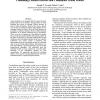Free Online Productivity Tools
i2Speak
i2Symbol
i2OCR
iTex2Img
iWeb2Print
iWeb2Shot
i2Type
iPdf2Split
iPdf2Merge
i2Bopomofo
i2Arabic
i2Style
i2Image
i2PDF
iLatex2Rtf
Sci2ools
105
click to vote
AAAI
2011
2011
Combining Learned Discrete and Continuous Action Models
Action modeling is an important skill for agents that must perform tasks in novel domains. Previous work on action modeling has focused on learning STRIPS operators in discrete, relational domains. There has also been a separate vein of work in continuous function approximation for use in optimal control in robotics. Most real world domains are grounded in continuous dynamics but also exhibit emergent ties at an abstract relational level of description. These two levels of regularity are often difficult to capture using a single action representation and learning method. In this paper we describe a system that combines discrete and continuous action modeling techniques in the Soar cognitive architecture. Our system accepts a continuous state representation from the environment and derives a relational state on top of it using spatial relations. The dynamics over each representation is learned separately using two simple instance-based algorithms. The predictions from the individual mo...
AAAI 2011 | Action Representation | Cognitive Architecture | Continuous Dynamics | Intelligent Agents |
Related Content
| Added | 12 Dec 2011 |
| Updated | 12 Dec 2011 |
| Type | Journal |
| Year | 2011 |
| Where | AAAI |
| Authors | Joseph Z. Xu, John E. Laird |
Comments (0)

